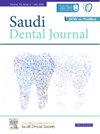ormocer纳米杂化复合材料与udma基纳米复合材料在咖啡浸泡后颜色稳定性的比较-实验研究
IF 2.3
Q3 DENTISTRY, ORAL SURGERY & MEDICINE
引用次数: 0
摘要
复合材料的颜色稳定性是影响牙体修复寿命的重要因素。一旦进入口腔,牙科材料必须提供抗环境污染的能力,如咖啡。本实验研究比较了两种不同纳米组成的复合树脂材料的颜色稳定性。目的分析咖啡对纳米杂化复合材料和纳米复合材料颜色稳定性的影响。材料和方法共使用了40个复合材料光盘,其中20个是基于ormocer的纳米复合材料(Admira Fusion), 20个是基于udma的纳米复合材料(Normofill nanoceram)。然后将每种材料的10个圆盘浸泡在咖啡或水中12天。在染色前后使用VITA易色分光光度计进行颜色测量。使用CIE L*a*b*值计算两种复合材料的色差(ΔE)。结果ormocer基纳米杂化复合材料(Admira Fusion)和udma基纳米复合材料(Normo填充纳米陶瓷)在12天后都出现了颜色变化。与基于ormocer的纳米混合复合材料(Admira Fusion)相比,基于udma的纳米复合材料(Normo填充纳米陶瓷)表现出明显更多的变色。总的来说,与水相比,浸泡在咖啡中产生的颜色有显著差异。此外,与基于udma的纳米复合材料(Normo填充纳米陶瓷)相比,基于ormocer的纳米复合材料(Admira Fusion)表现出更大的颜色稳定性。本文章由计算机程序翻译,如有差异,请以英文原文为准。
Colour stability comparison between ormocer nanohybrid composites and udma-based nanocomposites after immersion in coffee – Experimental study
Introduction
Colour stability of composite materials is an essential property that greatly influences the longevity of dental restorations. Once in the oral cavity, dental materials must provide a stain resistance ability against environmental exposures, such as coffee. This experimental study compares the colour stability of two composite resin materials with differing nanocompositions.
Objectives
Analyze the effect of coffee on the colour stability of nanohybrid composites and nanocomposites.
Material and Methods
40 composites discs were utilized in total, with 20 fabricated of an Ormocer-based nanohybrid composite (Admira Fusion) and 20 of a UDMA-based nanocomposite (Normofill nanoceram) in shade A2. 10 discs of each material were then immersed in coffee or water for 12 days. Colour measurements were taken before and after the staining period using a VITA Easyshade spectrophotometer. The colour difference (ΔE) of both composites was calculated using the CIE L*a*b* values.
Results
Both Ormocer-based nanohybrid composites (Admira Fusion) and UDMA-based nanocomposites (Normo fill nanoceram) exhibited a colour change after the 12-day period. The UDMA-based nanocomposite (Normo fill nanoceram) exhibited significantly more discolouration compared to the Ormocer-based nanohybrid composite (Admira Fusion).
Conclusions
Overall, there was a significant difference in colour generated by immersion in coffee as compared to water. Additionally, the Ormocer-based nanohybrid composite (Admira Fusion) exhibited significantly greater colour stability as compared to the UDMA-based nanocomposite (Normo fill nanoceram).
求助全文
通过发布文献求助,成功后即可免费获取论文全文。
去求助
来源期刊

Saudi Dental Journal
DENTISTRY, ORAL SURGERY & MEDICINE-
CiteScore
3.60
自引率
0.00%
发文量
86
审稿时长
22 weeks
期刊介绍:
Saudi Dental Journal is an English language, peer-reviewed scholarly publication in the area of dentistry. Saudi Dental Journal publishes original research and reviews on, but not limited to: • dental disease • clinical trials • dental equipment • new and experimental techniques • epidemiology and oral health • restorative dentistry • periodontology • endodontology • prosthodontics • paediatric dentistry • orthodontics and dental education Saudi Dental Journal is the official publication of the Saudi Dental Society and is published by King Saud University in collaboration with Elsevier and is edited by an international group of eminent researchers.
 求助内容:
求助内容: 应助结果提醒方式:
应助结果提醒方式:


